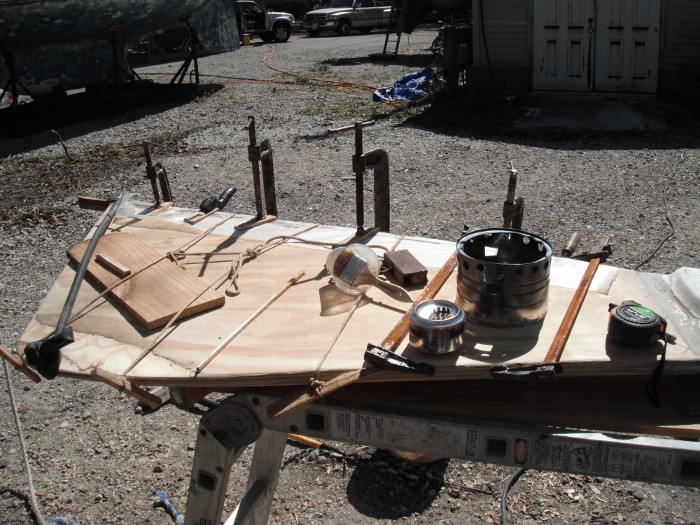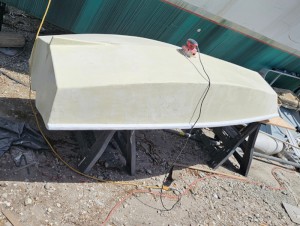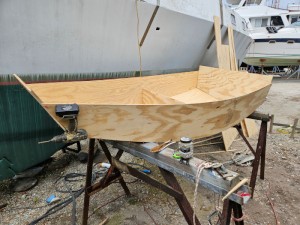Kaimusailing
s/v Kaimu Wharram Catamaran
| Vessel Name: | Kaimu |
| Vessel Make/Model: | Wharram Custom |
| Hailing Port: | Norwalk, CT |
| Crew: | Andy and the Kaimu Crew |
| About: | Sailors in the Baltimore, Annapolis, DC area. |
17 April 2024 | St Marys, GA
Dinghy Skeg
I was suffering with what seemed like a cold and also had allergy symptoms. I awoke and felt fine. The green pollen that was coating everything was gone. Maybe it will return.
07 April 2024 | St. Marys, GA
Clammy Hands
Items came in from TEMU, the Chinese cut rate retailer. One was a nice little drone that cost about twelve and a half dollars. It looked like an easy thing to play with while I coughed and sneezed. I was fighting a summer cold, even though it is not summer elsewhere, it seems like it here. A nice [...]
02 April 2024 | St. Marys, GA
Sun Doggie
After laminating the cedar strips onto the gunwales of the dinghy I found the screws I used wouldn’t come out. The epoxy had seized them. The screw heads were stripped so I cut a straight slot in the heads with the cut off wheel. The cedar smoked when the screw heads got red hot. I could remove [...]
21 March 2024 | St. Marys, GA
Just Add Water
The rainy weekend started off with overcast and fog but no rain. It looked like I might be able to get something done on the D4 dinghy. I wanted to change the bow seat which is really the bow deck. The sailing option uses the deck to hold the freestanding mast. I didn’t like how the deck looked, [...]
01 March 2024 | St. Marys, GA
D4 Dinghy Alternative Seats
The rain event was more wind than rain, strong winds with gusts up to 44 mph. We drove into town to see what the harbor was like. There was a small sailboat that had dragged anchor and was sitting close to shore. The tide was out. We left and played with Bleu at Notter’s Pond.
23 February 2024 | St. Marys, GA
D4 Inside Seams
Day two of the dinghy build started out with me finishing wiring the hull bottoms together on the centerline of the bottom panels. This was much easier than the wiring of the chine edges of the bottom panels and the side panels.
Fosters Pyro Stove

.
The problem is that the older computers never had so many virtual comm ports, so the software could be written to only look for comm 1-4, since they were hard wired actual ports on the computer frame. The work around to eliminate the excess comm ports was found on the internet and I won’t offer it here, it’s easily found by googling “renumbering comm ports”. Now, when the new serial adapter was plugged in, it appeared as “Comm 4“, and the firmware was updated to the latest. The 3 maps that had been downloaded added up to only about 750 kilobytes, and the unit had 12 megs of storage on it, so many more maps can be loaded.
.
Work on the starboard rudder continued. The leading edge of the rudder blade was rough looking and after trimming would be short of where the leading edge should be. I cut it off straight and glued on a cedar strip to make up the difference. While I was in epoxy mode, I primed one side of both skegs with raw epoxy.
.
The next morning was very chilly and there was frost on the deck. The epoxy of course was not completely hardened, still soft. The cold weather got me motivated to build another alcohol stove.
.
The Origo cannisters needed replacement and they are prohibitively expensive, considering what can be done with a soda can. Yes, they can be replaced by a simple “penny stove”. I already had made a simple cannister out of a Fosters beer can and tested it. While looking at DIY stoves, I came across a website that can be found by googling “zen alcohol stove”. It has lots of information about them. I decided to build a “pressurized jet” stove out of two Fosters bottoms. I followed the usual method described on that site and test fired it to see how tall the flame was so that I could design an appropriate wind screen/pot stand. The stove burner needs something above it to hold the frying pan and usually that device doubles as a windscreen. Since we will be cooking in the galley, no wind screen is needed, it is just to hold up the cooking pot.
.
I used an empty Chock full o Nuts can. It was too tall, so I cut it down to the size shown in the picture. Holes were drilled around the top edge to allow the flame to breath, as well as air intakes down lower. The plan was to keep the amount of air flow to a minimum while providing enough oxygen for the stove. The pressurized jet design depends on a warming pan, which in this case is the bottom of the coffee can, where a small splash of alcohol is ignited to warm the stove burner, which then begins to burn as the alcohol boils inside it.
.
The test firing of the stove, all assembled, used 3 oz. of alcohol in the burner, and boiled a half liter of water in the teapot in 3 minutes. It kept burning for a total of 13 minutes. These numbers compare favorably with those published online of other similar stoves. The larger size of the Fosters can boiled the water quicker than any of the others I saw online. The heat of the stove is more intense than I expected, so to cook without burning the bottom of the pan a “pizza stone’ is used to moderate the heat.
.
The picture is of the artistic clamping of the rudder’s leading edge, using a bicycle tube for one of the clamps, and the stove parts are there as well.






